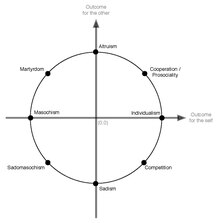Rational choice theory refers to a set of guidelines that help understand economic and social behaviour. The theory originated in the eighteenth century and can be traced back to political economist and philosopher, Adam Smith. The theory postulates that an individual will perform a cost-benefit analysis to determine whether an option is right for them. It also suggests that an individual's self-driven rational actions will help better the overall economy. Rational choice theory looks at three concepts: rational actors, self interest and the invisible hand.
Pareto efficiency or Pareto optimality is a situation where no action or allocation is available that makes one individual better off without making another worse off. The concept is named after Vilfredo Pareto (1848–1923), Italian civil engineer and economist, who used the concept in his studies of economic efficiency and income distribution. The following three concepts are closely related:
As a topic of economics, utility is used to model worth or value. Its usage has evolved significantly over time. The term was introduced initially as a measure of pleasure or happiness as part of the theory of utilitarianism by moral philosophers such as Jeremy Bentham and John Stuart Mill. The term has been adapted and reapplied within neoclassical economics, which dominates modern economic theory, as a utility function that represents a single consumer's preference ordering over a choice set but is not comparable across consumers. This concept of utility is personal and based on choice rather than on pleasure received, and so is specified more rigorously than the original concept but makes it less useful for ethical decisions.

Prospect theory is a theory of behavioral economics and behavioral finance that was developed by Daniel Kahneman and Amos Tversky in 1979. The theory was cited in the decision to award Kahneman the 2002 Nobel Memorial Prize in Economics.

A choice is the range of different things from which a being can choose. The arrival at a choice may incorporate motivators and models. For example, a traveler might choose a route for a journey based on the preference of arriving at a given destination at a specified time. The preferred route can then account for information such as the length of each of the possible routes, the amount of fuel in the vehicle, traffic conditions, etc.
The expected utility hypothesis is a popular concept in economics that serves as a reference guide for decisions when the payoff is uncertain. The theory recommends which option rational individuals should choose in a complex situation, based on their risk appetite and preferences.
Moral psychology is a field of study in both philosophy and psychology. Historically, the term "moral psychology" was used relatively narrowly to refer to the study of moral development. Moral psychology eventually came to refer more broadly to various topics at the intersection of ethics, psychology, and philosophy of mind. Some of the main topics of the field are moral judgment, moral reasoning, moral sensitivity, moral responsibility, moral motivation, moral identity, moral action, moral development, moral diversity, moral character, altruism, psychological egoism, moral luck, moral forecasting, moral emotion, affective forecasting, and moral disagreement.
Game theory is the branch of mathematics in which games are studied: that is, models describing human behaviour. This is a glossary of some terms of the subject.
The dictator game is a popular experimental instrument in social psychology and economics, a derivative of the ultimatum game. The term "game" is a misnomer because it captures a decision by a single player: to send money to another or not. Thus, the dictator has the most power and holds the preferred position in this “game.” Although the “dictator” has the most power and presents a take it or leave it offer, the game has mixed results based on different behavioral attributes. The results – where most "dictators" choose to send money – evidence the role of fairness and norms in economic behavior, and undermine the assumption of narrow self-interest when given the opportunity to maximise one's own profits.
A collective action problem or social dilemma is a situation in which all individuals would be better off cooperating but fail to do so because of conflicting interests between individuals that discourage joint action. The collective action problem has been addressed in political philosophy for centuries, but was most clearly established in 1965 in Mancur Olson's The Logic of Collective Action.
In game theory, the traveler's dilemma is a non-zero-sum game in which each player proposes a payoff. The lower of the two proposals wins; the lowball player receives the lowball payoff plus a small bonus, and the highball player receives the same lowball payoff, minus a small penalty. Surprisingly, the Nash equilibrium is for both players to aggressively lowball. The traveler's dilemma is notable in that naive play appears to outperform the Nash equilibrium; this apparent paradox also appears in the centipede game and the finitely-iterated prisoner's dilemma.
Rabin fairness is a fairness model invented by Matthew Rabin. It goes beyond the standard assumptions in modeling behavior, rationality and self-interest, to incorporate fairness. Rabin's fairness model incorporates findings from the economics and psychology fields to provide an alternative utility model. Fairness is one type of social preference.
Prosocial behavior, or intent to benefit others, is a social behavior that "benefit[s] other people or society as a whole", "such as helping, sharing, donating, co-operating, and volunteering". Obeying the rules and conforming to socially accepted behaviors are also regarded as prosocial behaviors. These actions may be motivated by empathy and by concern about the welfare and rights of others, as well as for egoistic or practical concerns, such as one's social status or reputation, hope for direct or indirect reciprocity, or adherence to one's perceived system of fairness. It may also be motivated by altruism, though the existence of pure altruism is somewhat disputed, and some have argued that this falls into philosophical rather than psychological realm of debate. Evidence suggests that pro sociality is central to the well-being of social groups across a range of scales, including schools. Prosocial behavior in the classroom can have a significant impact on a student's motivation for learning and contributions to the classroom and larger community. In the workplace, prosocial behaviour can have a significant impact on team psychological safety, as well as positive indirect effects on employee's helping behaviors and task performance. Empathy is a strong motive in eliciting prosocial behavior, and has deep evolutionary roots.

Helping behavior refers to voluntary actions intended to help the others, with reward regarded or disregarded. It is a type of prosocial behavior.
Social preferences describe the human tendency to not only care about one's own material payoff, but also the reference group's payoff or/and the intention that leads to the payoff. Social preferences are studied extensively in behavioral and experimental economics and social psychology. Types of social preferences include altruism, fairness, reciprocity, and inequity aversion. The field of economics originally assumed that humans were rational economic actors, and as it became apparent that this was not the case, the field began to change. The research of social preferences in economics started with lab experiments in 1980, where experimental economists found subjects' behavior deviated systematically from self-interest behavior in economic games such as ultimatum game and dictator game. These experimental findings then inspired various new economic models to characterize agent's altruism, fairness and reciprocity concern between 1990 and 2010. More recently, there are growing amounts of field experiments that study the shaping of social preference and its applications throughout society.
Moral development focuses on the emergence, change, and understanding of morality from infancy through adulthood. Morality develops across a life span in a variety of ways and is influenced by an individual's experiences and behavior when faced with moral issues through different periods of physical and cognitive development. Morality concerns an individual's reforming sense of what is right and wrong; it is for this reason that young children have different moral judgment and character than that of a grown adult. Morality in itself is often a synonym for "rightness" or "goodness." It also refers to a specific code of conduct that is derived from one's culture, religion or personal philosophy that guides one's actions, behaviors and thoughts.
Interdependence theory is a social exchange theory that states that interpersonal relationships are defined through interpersonal interdependence, which is "the process by which interacting people influence one another's experiences"(Van Lange & Balliet, 2014, p. 65). The most basic principle of the theory is encapsulated in the equation I = ƒ[A, B, S], which says that all interpersonal interactions (I) are a function (ƒ) of the given situation (S), plus the actions and characteristics of the individuals in the interaction. The theory's four basic assumptions are 1) The Principle of Structure, 2) The Principle of Transformation, 3) The Principle of Interaction, and 4) The Principle of Adaption.
Allocentrism is a collectivistic personality attribute whereby people center their attention and actions on other people rather than themselves. It is a psychological dimension which corresponds to the general cultural dimension of collectivism. In fact, allocentrics "believe, feel, and act very much like collectivists do around the world." Allocentric people tend to be interdependent, define themselves in terms of the group that they are part of, and behave according to that group's cultural norms. They tend to have a sense of duty and share beliefs with other allocentrics among their in-group. Allocentric people appear to see themselves as an extension of their in-group and allow their own goals to be subsumed by the in-group's goals. Additionally, allocentrism has been defined as giving priority to the collective self over the private self, particularly if these two selves happen to come into conflict.
Behavioral game theory seeks to examine how people's strategic decision-making behaviour is shaped by social preferences, social utility and other psychological factors. Behavioral game theory analyzes interactive strategic decisions and behavior using the methods of game theory, experimental economics, and experimental psychology. Experiments include testing deviations from typical simplifications of economic theory such as the independence axiom and neglect of altruism, fairness, and framing effects. As a research program, the subject is a development of the last three decades.
In cooperative game theory, a hedonic game is a game that models the formation of coalitions (groups) of players when players have preferences over which group they belong to. A hedonic game is specified by giving a finite set of players, and, for each player, a preference ranking over all coalitions (subsets) of players that the player belongs to. The outcome of a hedonic game consists of a partition of the players into disjoint coalitions, that is, each player is assigned a unique group. Such partitions are often referred to as coalition structures.












